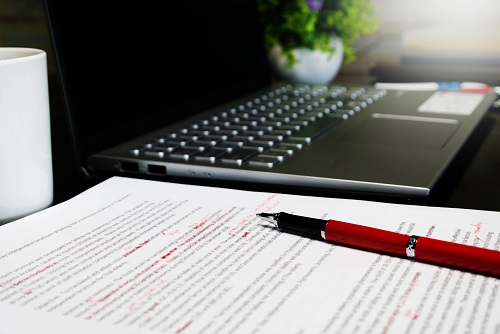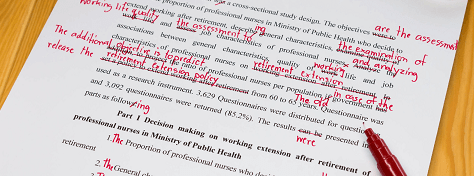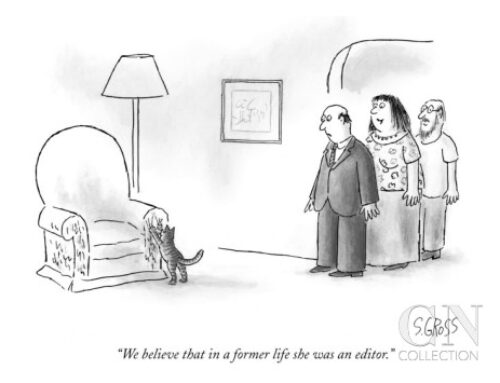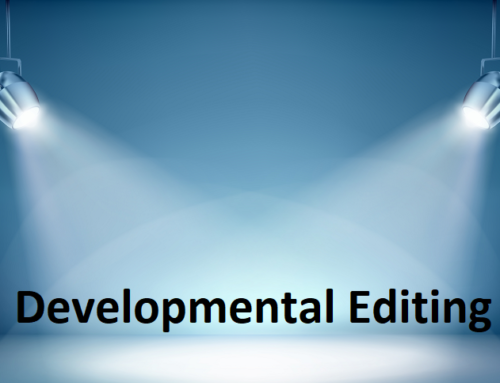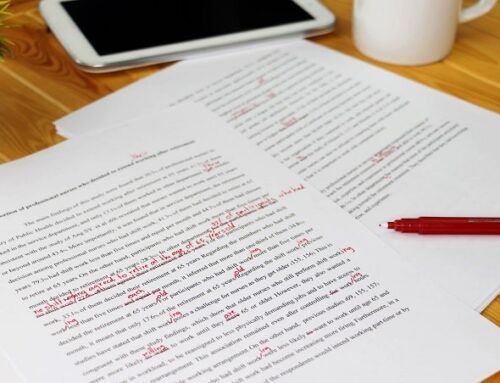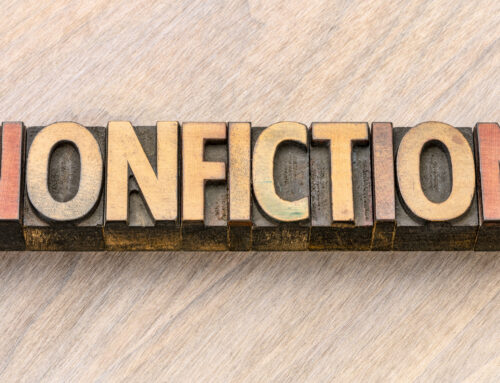Line editing, copy editing, and proofreading are all hands-on services where your editor works with the words on the page directly. While there is some degree of overlap in the purview of each service, these are three fundamentally different kinds of editing that serve three very specific objectives. Understanding what each service is and the circumstances where it’s needed will help you make informed choices about what is best for your manuscript, when it should happen, and in what order it should happen if you need more than one of these services. (We can provide guidance on this, of course.)
How line editing and copy editing are delivered
When we opened our doors in 1980, back before computers were commonplace, line editing and copy editing looked like this:
Nowadays, it’s a lot easier for author and editor alike. Programs such as Microsoft Word track your editor’s proposed changes and allow you to accept, reject, or modify each edit as you see fit—or to accept them all globally A typical line edited or copy edited deliverable will come to you looking like this:
Here’s a quick summary of the intent of each service.
In simple terms, line editing helps maximize the readability, clarity, and artfulness of your prose. It’s the last thing to happen to a manuscript before copy editing and is always done while the manuscript is still an editable document and not yet laid out for publication.
Copy editing corrects your text and its formatting—and in many cases ensures consistent adherence to a style guide of your choosing. It’s the very last thing to happen to a manuscript while it’s still in editable form in a program such as Microsoft Word.
Proofreading provides a final editorial review to flag errors or typos that may be present, usually in a pre-publication galley or a post-layout PDF, and directs a typesetter on the needed fixes. By this point the manuscript has been laid out for publication, so the editing comes via notes in an Adobe PDF file rather than tracked changes in Microsoft Word. Proofreaders will watch for layout and typographic anomalies along with any last errors that may need correction.
Understanding the difference between developmental editing and sentence-level editing
One important thing to keep in mind about any kind of sentence-level editing is that it is not a substitute for developmental editing. In addition, it’s not an appropriate vehicle for addressing substantive matters of story or content, nor big-picture, book-spanning issues best tackled in the revision stage.
Sentence-level editing focuses not on what you’ve written but on how you’ve written it. This is why it only makes sense to line edit, copy edit, or proofread a manuscript after all revision work is complete and once you’re 100% confident that your work is sufficiently sound in content, structure, and organization to be ready for final polishing and correction. (Developmental editing and revision guidance are tools that help authors bring manuscripts to this stage. You can read more about them here.)
Here’s some more information about what each type of sentence-level editing is and what it’s intended to do. Please keep in mind that not every manuscript needs all three tiers of sentence-level editing. But when a manuscript does need one or more of these line-level services, it’s important to work in the correct order.
There’s no sense in doing a copy edit before a line edit, or proofread before a copy edit. Nor (as we’ve said—we can’t stress this enough) does it make sense to do any sentence editing before developmental editing. To approach the process in any other order is simply a waste of time, effort, and money.
LINE EDITING
For fiction, the first duty of a good line editor is to polish the writing, elevate the style of the work, and make the prose as pleasing, engaging, and readable as possible. We approach line editing for creative nonfiction and narrative nonfiction in much the same way, focusing primarily on artful storytelling and a satisfying overall aesthetic to the writing.
Line editing for more technical and expository nonfiction—science, medicine, history, self-help, philosophy, etc.—often involves attention to clarity, proportion, and how effectively you are expressing your ideas and information. But the goal is the same: to help the manuscript read as smoothly and professionally as possible.
A line-edited manuscript will demonstrate careful attention to phrasing and language and will help it come across as well written. In other words, line editing helps make your prose more of an asset to the overall experience of the book. For this reason, it’s a very common step before submission of a manuscript to literary agents and publishers.
Because every book is different, there’s no accurate way to generalize what exactly a line edit would entail, but the objective is pretty much always the same: to make your writing shine. Learn more…
COPY EDITING
The first duty of a copy editor is to correct grammar, spelling, punctuation, and word usage. The second is to ensure proper consistency in these matters over the full span of the manuscript, often following a specific style guide. The third is to correct or improve formatting of your text, often in preparation for typesetting and page layout.
In copy editing, unlike line editing, any changes to the wording of the manuscript itself will be in the interest of consistency and clarity rather than for aesthetic polishing or elevation of narrative voice. Copy editing often involves fact checking and will sometimes include queries to the author to help clarify a point or ensure that intended meaning is preserved.
Copy editing is a highly specialized and somewhat technical kind of editing that keeps typos, errors, and stylistic or formatting inconsistencies from compromising the professionalism or the end result.
Various style guides, such as those of AP, MLA, and APA, can be used as references to ensure consistency with copy editing. Our default is The Chicago Manual of Style, but we can often work with other style guides when needed. Learn more…
PROOFREADING
In most cases, this is a painstaking review of the manuscript “proof” copy—that is, text that has been typeset and needs to be checked for correctness prior to printing or e-book release. These days proofreading is most often done on a PDF document after a manuscript has been through electronic layout. (The exception is if you’re self-publishing an e-book with no print version, in which case the proofread would be done using Word, prior to e-book formatting.)
If you’re planning to pursue traditional publication, you probably won’t need a proofread, as it’s a production-level edit that is only appropriate after a manuscript destined for publication has been copy edited. If you’re planning to self-publish, you’ll need copy editing and proofreading, but the proofread will happen after layout (again, except for e-books). Learn more…
We hope this information is helpful if you’re considering any kind of sentence-level editing. Please don’t hesitate to contact Ross Browne in the Tucson office with questions or to request a quote.

